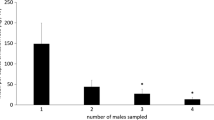Abstract
Two experiments were conducted to investigate the use of a pheromone-based trap-out technique for suppressing populations ofScolytus multistriatus. In the first experiment, elm bolts containing the immature stages ofS. multistriatus were placed in an isolated community that contained elm trees, but which was essentially devoid of a resident beetle population. The infested bolts produced a total of 46,485 adult beetles of which 20% were recovered on traps baited with synthetic pheromone. In the second experiment beetles were released in a desert valley containing no resident elms or beetles. Only 1% of 20,000 released beetles were recaptured on traps erected on vertical cardboard cylinders and on elm logs. These rates of recapture are related to the attraction of beetles to naturally occurring brood sources versus pheromone-baited traps.
Similar content being viewed by others
References
Al-Azawi, A.F., andCasida, J.E. 1958. The efficiency of systemic insecticides in the control of the smaller european elm bark beetle.J. Econ. Entomol. 51:789–790.
Arciero, M.F. 1979. Use of multilure-baited traps on the California Dutch elm disease program for survey and detection ofScolytus multistriatus.Bull. Entomol. Soc. Am. 25:119–121.
Barger, J. H. 1977. Improved sanitation practice for control of Dutch elm disease. Forest Service Research Paper NE-386, 4 pp.
Birch, M.C. 1979. Use of pheromone traps to suppress populations ofScolytus multistriatus in small, isolated Californian communities.Bull. Entomol. Soc. Am. 25:112–115.
Birch, M.C., Bushing, R.W., Paine, T.D., Clement, S.L., andSmith, P.D. 1977. Pheromone traps to suppress populations of the smaller European elm bark beetle.Calif. Agric. 31:14–16.
Birch, M.C., Paine, T.D., andMiller, J.C. 1981. Effectiveness of pheromone mass-trapping for the elm bark beetle.Calif. Agric. 35:6–7.
Browne, L.E. 1972. An emergence cage and refrigerated collector for wood-boring insects and their associates.J. Econ. Entomol. 65:1499–1501.
Cuthbert, R.A.,Barger, J.H.,Lincoln, A.C., andReed, P.A. 1973. Formulation and application of methoxyclor for elm bark beetle control. USDA Forest Service Research Paper, Northeastern Forest Experiment Station No. NE-283, 6 pp.
Cuthbert, R.A., andPeacock, J.W. 1978. Response of the elm bark beetle,Scolytus multistriatus to component mixtures and doses of the pheromone, multilure.J. Chem. Ecol. 3:363–373.
Cuthbert, R.A., andPeacock, J.W. 1979. The Forest Service program for mass-trappingScolytus multistriatus.Bull. Entomol. Soc. Am. 25:105–108.
Cuthbert, R.A., Peacock, J.W., andCannon, W.N., Jr. 1977. An estimate of the effectiveness of pheromone-baited traps for the suppression ofScolytus multistriatus.J. Chem. Ecol. 3:527–537.
Gore, W.E., Pearce, G.T., Lanier, G.N., Simeone, J.B., Silverstein, R.M., Peacock, J.W., andCuthbert, R.A. 1977. Aggregation attractant of the European elm bark beetles,Scolytus multistriatus. Production of individual components and related aggregation behavior.J. Chem. Ecol. 3:429–446.
Hart, J.H. 1970. Attempts to control Dutch elm disease by pruning.Plant Dis. Rep. 54:985–986.
Kennedy, B.H. 1979. The effect of multilure on parasites of the European elm bark beetle,Scolytus multistriatus.Bull. Entornol. Soc. Am. 25:116–118.
Lanier, G.N. 1978. Behavior-modifying chemicals as a basis for managing bark beetles of urban importance, pp. 295–310,in G.W. Frankie and C.S. Koehler (eds.). Perspectives in Urban Entomology. Academic Press, New York.
Lanier, G.N. 1979. Protection of elm groves by surrounding them with multilure-baited sticky traps.Bull. Entornol. Soc. Am. 25:109–111.
Lanier, G.N., Silverstein, R.M., andPeacock, J.W. 1976. Attractant pheromone of the european elm bark beetle (Scolytus multistriatus): Isolation, identification, synthesis, and utilization studies, pp. 146–175,in J.F. Anderson and H.K. Kaya (eds.). Perspectives in Forest Entomology. Academic Press, New York.
Miller, H.C., Silverborg, S.B., andCampana, R.J. 1969. Dutch elm disease relation of spread and intensification to control by sanitation in Syracuse, New York.Plant Dis. Rep. 53:551–555.
O'callaghan, D.P., Gallagher, E.M., andLanier, G.N. 1980. Field evaluation of pheromonebaited trap trees to control elm bark beetles, vectors of dutch elm disease.Envir. Entomol. 9:181–185.
Peacock, J.W., Lincoln, A.C., Simeone, J.B., andSilverstein, R.M. 1971. Attraction ofScolytus multistriatus to a virgin-female-produced pheromone in the field.Ann. Entomol. Soc. Am. 64:1143–1149.
Pearce, G.T., Gore, W.E., Silverstein, R.M., Peacock, J.W., Cuthbert, R.A., Lanier, G.N., andSimeone, J.B. 1975. Chemical attractants for the smaller european elm bark beetle,Scolytus multistriatus.J. Chem. Ecol. 1:115–124.
Truchan, J.G. 1970. Field evaluation ofDendrosoter protuberans as a biological control agent forScolytus multistriatus, the primary vector of Dutch elm disease. Ph.D. thesis, Michigan State University, 97 pp.
Valek, D.A. 1967. Study of the host-parasite relationships ofScolytus multistriatus and the methods of propogation for the introduced parasiteDendrosoter protuberans. M.S. thesis, Michigan State University, 70 pp.
Williams, C.H., andBrown, H.E. 1969. Some biological investigations of the smaller European elm bark beetle in Missouri with reference to systemic insecticidal control.J. Econ. Entomol. 62:1381–1386.
Wollerman, E.H. 1979a. Dispersion and invasion byScolytus multistriatus in response to pheromone.Envir. Entomol. 8:1–5.
Wollerman, E.H. 1979b. Attraction of European elm bark beetlesScolytus multistriatus to pheromone baited traps.J. Chem. Ecol. 5:781–793.
Author information
Authors and Affiliations
Additional information
Coleoptera: Scolytidae.
Rights and permissions
About this article
Cite this article
Birch, M.C., Miller, J.C. & Paine, T.D. Evaluation of two attempts to trap defined populations ofScolytus multistriatus . J Chem Ecol 8, 125–136 (1982). https://doi.org/10.1007/BF00984010
Received:
Revised:
Issue Date:
DOI: https://doi.org/10.1007/BF00984010




